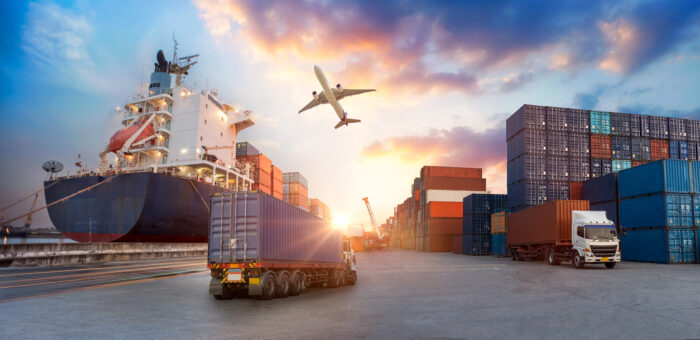Each one of us has been hit by the shipping crisis in a different way. Many people wonder if there is an end in sight to the shipping crisis. We decided to get an expert’s point of view and enlisted the help of our friends at Falvey Insurance Group. Falvey is the parent company of Falvey Cargo Underwriting, the leading cargo underwriting firm in the country. They are keenly aware of what is happening in the shipping and cargo world. So, we decided to ask them about the current state of affairs and what they see in the future.
Ask the Experts
When it comes to finding an end to the shipping crisis, we knew we needed to talk to experts. We interviewed Dan Graves, Vice President of Falvey Cargo Underwriting, and Eric Newman, Senior Vice President, ProTecht Risk Solutions, Falvey Insurance Group’s claims, loss prevention, and recoveries department.

Q: In terms of creative strategies for dealing with current supply chain challenges, what are some that will be carried into the future?
A: Rather than looking at the response to this life-changing disruption, I think some changes are going to happen as far as overall supply chain management. One of the reasons for the problems that we’re seeing is that companies are operating lean just-in-time inventory management systems which are not tolerant of any disruption and place tremendous stress and strain on the normal supply chain cycles for companies. When you experience the massive disruptions were are seeing currently throughout the global supply chain, the effects are a lot worse because you have fewer products, and as the products build-up, you develop a backlog. I think what we’re going to see is companies focusing on more accurate and strategic forecasting models for their supply chain operations, which take into consideration reduced supply and longer transit times. Rather than worry about the cost, I think we’re going to see companies move from a “just-in-time” inventory system to more of a “just-in-case” strategy. That has a ripple effect for everything, including larger inventories which will result in larger exposures at warehouses and distribution centers. That means a lot more risk from an insurance perspective, as far as what we’re used to seeing.
Q: Is there a more sophisticated way these concepts can be integrated into supply chain management?
A: Small to medium-size businesses will need to look at how they are doing things in order to compete with the Amazons and other “Big Box” stores that have buying capacity. It’s going to make it that much more difficult for some of these smaller companies to compete, even more so than before all of this started.
Q: Is there a good alternative to standard shipping containers? Do you see any of these creative strategies moving forward?
A: I don’t think it can get more sophisticated. These alternative methods, including the use of converted bulk vessels to carry containerized cargo, are not sophisticated. We’re also seeing an increase in goods being shipped via break-bulk (non-containerized). This is happening because of the reduction of available container vessel capacity. I think what’s scary from an insurance perspective is shipping containers on converted vessels that were not designed for the carriage of intermodal containers. These vessels are not set up for this and have to be customized to accommodate the carriage of containers. The paradox there is we are seeing more shipping containers lost overboard than ever before in the North Pacific. (According to Marine Link, the industry is seeing the biggest spike in lost containers at sea in seven years.) These are state-of-the-art shipping vessels that are made to transport containers. Now we’re taking these converted vessels and taking them on the same lane and putting them in the same weather conditions. If the state-of-the-art vessels which are designed to carry these containers are experiencing issues with losing containers overboard, I can only imagine what we should be expecting with some of the converted vessels transiting the same lane. The potential could be catastrophic.
Q: Are companies going to start chartering their own vessels?
A: What we might see coming out of this is companies coming up with their own container vessel fleet. This will likely become much more prevalent. That would be on a strict charter basis or they will own the vessels outright. I don’t see the converted vessel strategy prevailing, rather the focus will remain on the use of the ultra-large container vessels (ULCV) to transport these containers, which brings in a whole other set of risks and exposures that we can discuss at another time.
We fully expect this supply chain disruption and backlog to ease at some point but we don’t see it going away completely. There will be everlasting effects from what has happened over the last 2 years.
Q: Do you see any potential for significant port diversification?
A: The long-term push has been there since the completion of the expansion of the Panama Canal in 2016. This crisis has exposed the overall lack of infrastructure in the U.S. to handle significantly increased cargo flow. It’s not just the container ports, but also the rail system, roadways, trucking industry, and warehousing capacity which have been dramatically stressed during this crisis. It really has been the perfect storm of events for the domestic and global supply chains.
Q: Is there anything else that could make the situation worse?
A: Political upheaval. So much relies on overseas manufacturing. It would have to be political unrest that would close ports and borders. We’re focusing on container freight, but it is not isolated to just that type of shipping. It’s across all shipping modes and commodities.
Q: What about air cargo?
A: What this disruption has done is saturate the air freight market. What we’ve seen on the claims side is a dramatic increase in delay. Whether it’s covered under our policy or not. The thing that scares me is I don’t think we’ve seen a lot of the claims. Our customers are not going to file a claim unless they hear about the disposition of the cargo or receive it late. (Disposition in freight shipping occurs when the freight is refused by the consignee and returned to the shipping terminal.) You pile this on top of some of the delays that have already happened and I fully suspect we will see more delays. I’ll use Chicago as an example. Chicago is fed by seven railway lines and the conditions and backlog right now are enormous. Everything in and out of Chicago is completely bogged down. That is a major hub for US commerce and the bottlenecks are a significant factor in the supply chain disruption we are seeing in the U.S. I think there will be more delays, more deteriorating conditions, more questionable claims. There is a snowball effect.

Q: What claims are you seeing?
A: Theft claims. Cargo at rest is cargo at risk. All of this cargo is sitting at ports with targets on them. We’re seeing shocking footage on the news where cargo theft is running rampant. One of the areas where this is happening is in and around the ports of LA and Long Beach. In a report from NBCLA, Union Pacific railroad said there was a rash of cargo container break-ins as the containers were being hauled by train near downtown Los Angeles, as officials are trying to clear the backlog of cargo at the Ports of Los Angeles and Long Beach.
Q: Are there any technology solutions to this problem?
A: Short answer – not really. Supply chain management will become much more detailed and formulaic going forward. There are more advanced supply chain management tools and platforms companies will begin to adopt and utilize to assist in their forecasting modeling.
Q: Can you give an example of the types of claims that could be prevented or mitigated by cyber awareness?
A: Certainly, fraudulent orders. We’re seeing more of those on a steadily increasing basis. Fraudulent orders where companies aren’t properly vetting their potential buyers. The hackers are using the old test method. They will attempt to order a shipment worth $1,000 or so they limit the attention paid towards the purchase and experience very little resistance. Then they try a little bit more. It’s akin to warehouse theft where thieves will purposely set off alarms and then sit back and gauge the facility/law enforcement response. After numerous “false alarms”, responses to these alarms lessen thus providing an opportunity for the thieves to access the targeted assets. I equate that to what we’re seeing on the cyber side of things. They start with little breaches and then the avalanche comes.
Q: Is it cyclical?
A: I don’t think so. Certainly, there will be aftershocks from the current situation. However, I don’t think it is very likely we will see things devolve to levels of this magnitude again. Once we clear the pipeline and infrastructure improvements are made, supply chains will adapt and grow more sophisticated which will hopefully help avoid a recurrence of the situation we are currently seeing.
Processing the shipping crisis
Thank you Eric and Dan for helping us process the complexity of the current shipping crisis. If you would like more information about Falvey Insurance Group, go here. If you would like more information about Diversified Insurance, go here.

